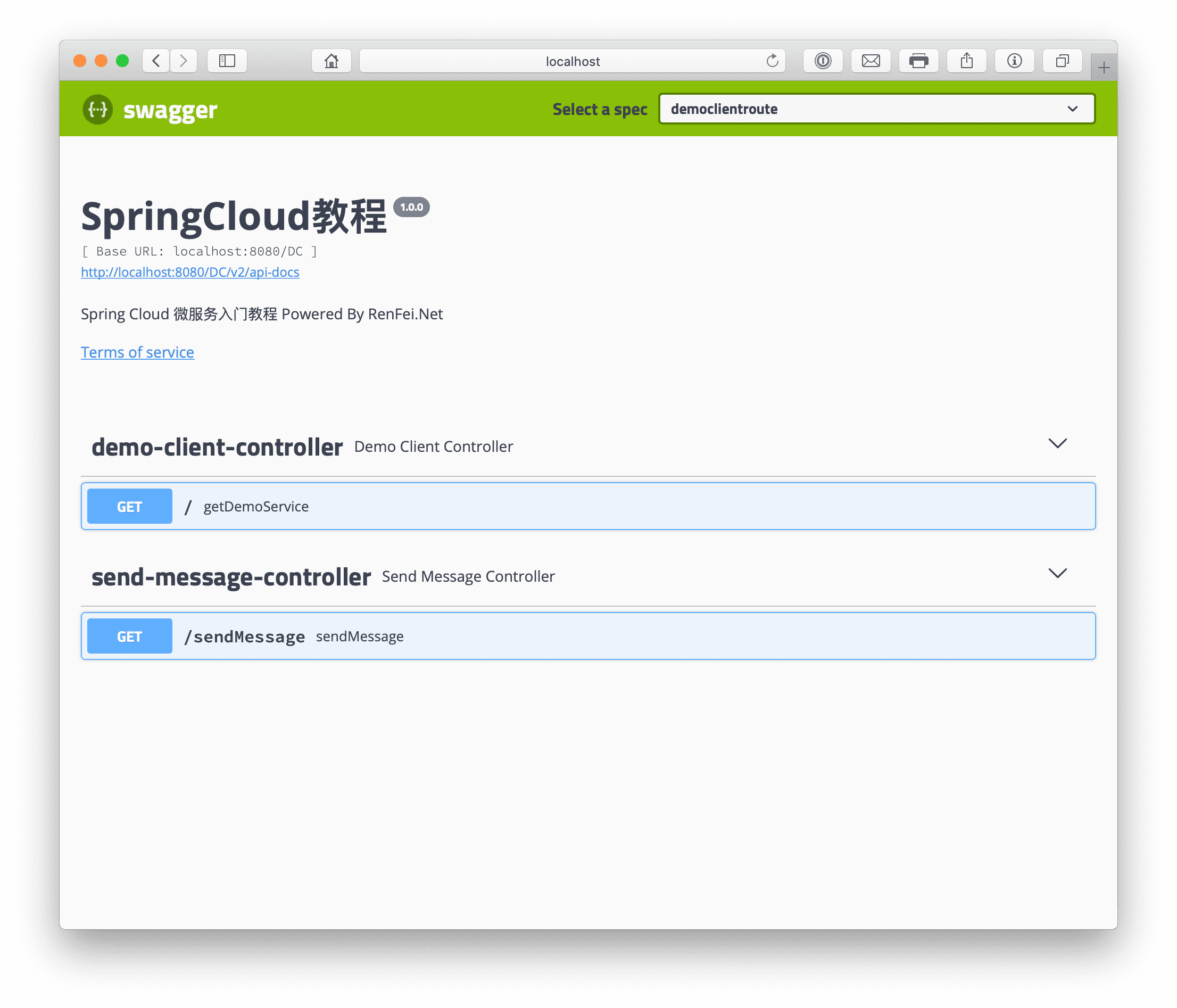Spring Cloud 微服务入门教程(九):网关 Zuul 整合 Swagger2 实现自动生成 RESTful API 文档
2020年02月29日 14:11:06 · 本文共 4,994 字阅读时间约 18分钟 · 4,143 次浏览
Spring Cloud 微服务入门教程(一):微服务介绍
Spring Cloud 微服务入门教程(二):服务注册与发现-Eureka
Spring Cloud 微服务入门教程(三):微服务的注册
Spring Cloud 微服务入门教程(四):微服务间的调用消费-FeignClient
Spring Cloud 微服务入门教程(五):统一配置中心-ConfigService
Spring Cloud 微服务入门教程(六):Spring Cloud BUS 消息总线实现配置中心动态更新配置文件
Spring Cloud 微服务入门教程(七):Spring Cloud Stream 消息队驱动式的微服务
Spring Cloud 微服务入门教程(八):Spring Cloud Zuul 服务网关动态路由和Cookie头信息传递和跨域
Spring Cloud 微服务入门教程(九):网关 Zuul 整合 Swagger2 实现自动生成 RESTful API 文档
Spring Cloud 微服务入门教程(十):Spring Cloud Hystrix 服务熔断和服务降级
Spring Cloud 微服务入门教程(十一):Spring Cloud Sleuth zipkin 服务追踪链路监控
Spring Cloud 微服务入门教程(十二):Spring Cloud Docker 容器化部署
代码 将在https://github.com/NeilRen/SpringCloudDemo进行分享,按不同的分支分享不同的章节代码,Master分支就是最后所有的内容合集。本章节代码在:https://github.com/NeilRen/SpringCloudDemo/tree/feature/spring-cloud-zuul-swagger2
原创 本篇文章是原创文章,作者:任霏,转载请注明作者和出处
上一节我们讲了SpringCloud的服务网关Zuul,随着服务接口的增加,我们还需要一个管理接口文档的工具,所以本节介绍给大家Swagger,这个不是微服务架构里的内容,但是非常实用,所以我也安排在入门教程中了,Swagger不但可以将接口可视化文档,还可以在线测试、生成SDK,本节主要讲整合Swagger,不去细讲Swagger的使用,后续我会专门写一篇关于Swagger使用的详细教程。
服务整合Swagger
我计划给每个服务接口都生成Swagger文档,所以我在项目的根POM文件中增加了Swagger的依赖,修改根POM文件:
<?xml version="1.0" encoding="UTF-8"?>
<project xmlns="http://maven.apache.org/POM/4.0.0"
xmlns:xsi="http://www.w3.org/2001/XMLSchema-instance"
xsi:schemaLocation="http://maven.apache.org/POM/4.0.0 http://maven.apache.org/xsd/maven-4.0.0.xsd">
<modelVersion>4.0.0</modelVersion>
<groupId>net.renfei</groupId>
<artifactId>cloud</artifactId>
<version>1.0.0</version>
<modules>
<module>eureka</module>
<module>apicenter</module>
<module>config</module>
<module>demoservice</module>
<module>democlient</module>
<module>gateway</module>
</modules>
<packaging>pom</packaging>
<name>SpringCloudDemo</name>
<description>Demo project for Spring Cloud By RENFEI.NET</description>
<properties>
<java.version>1.8</java.version>
<project.build.sourceEncoding>UTF-8</project.build.sourceEncoding>
<spring-cloud.version>Hoxton.SR1</spring-cloud.version>
<swagger.version>2.9.2</swagger.version>
</properties>
<parent>
<groupId>org.springframework.boot</groupId>
<artifactId>spring-boot-starter-parent</artifactId>
<version>2.2.4.RELEASE</version>
<relativePath/>
</parent>
<dependencies>
<dependency>
<groupId>org.springframework.boot</groupId>
<artifactId>spring-boot-starter-test</artifactId>
<scope>test</scope>
</dependency>
<dependency>
<groupId>org.projectlombok</groupId>
<artifactId>lombok</artifactId>
<optional>true</optional>
</dependency>
<dependency>
<groupId>io.springfox</groupId>
<artifactId>springfox-swagger2</artifactId>
<version>${swagger.version}</version>
</dependency>
<dependency>
<groupId>io.springfox</groupId>
<artifactId>springfox-swagger-ui</artifactId>
<version>${swagger.version}</version>
</dependency>
</dependencies>
<dependencyManagement>
<dependencies>
<dependency>
<groupId>org.springframework.cloud</groupId>
<artifactId>spring-cloud-dependencies</artifactId>
<version>${spring-cloud.version}</version>
<type>pom</type>
<scope>import</scope>
</dependency>
</dependencies>
</dependencyManagement>
<build>
<plugins>
<plugin>
<groupId>org.springframework.boot</groupId>
<artifactId>spring-boot-maven-plugin</artifactId>
</plugin>
</plugins>
</build>
</project>这样每个项目都有了Swagger的包,然后给每个微服务中增加配置类,我的演示项目中是demoservice、democlient和gateway三个项目,我以democlient为例,其他也是一样的,新增一个配置类:
package net.renfei.democlient.config;
import org.springframework.context.annotation.Bean;
import org.springframework.context.annotation.Configuration;
import springfox.documentation.builders.ApiInfoBuilder;
import springfox.documentation.builders.PathSelectors;
import springfox.documentation.builders.RequestHandlerSelectors;
import springfox.documentation.service.ApiInfo;
import springfox.documentation.spi.DocumentationType;
import springfox.documentation.spring.web.plugins.Docket;
import springfox.documentation.swagger2.annotations.EnableSwagger2;
/**
* Swagger2的配置
*
* @author RenFei
*/
@Configuration
@EnableSwagger2
public class SwaggerConfig {
public static final String VERSION = "1.0.0";
@Bean
public Docket createRestApi() {
return new Docket(DocumentationType.SWAGGER_2)
.apiInfo(apiInfo())
.select()
.apis(RequestHandlerSelectors.basePackage("net.renfei.democlient.controller"))
// 可以根据url路径设置哪些请求加入文档,忽略哪些请求
.paths(PathSelectors.any())
.build();
}
private ApiInfo apiInfo() {
return new ApiInfoBuilder()
//设置文档的标题
.title("SpringCloud教程")
// 设置文档的描述
.description("Spring Cloud 微服务入门教程 Powered By RenFei.Net")
// 设置文档的版本信息-> 1.0.0 Version information
.version(VERSION)
.termsOfServiceUrl("https://www.renfei.net")
.build();
}
}其中RequestHandlerSelectors.basePackage就是设置要扫描哪个包下的,每个项目各自设置各自的扫描包名。
在服务网关Zuul项目中除了添加上面的配置类以外,还需要一个配置类,因为这些服务的Swagger文档都分散在各个服务上,我们还需要手动添加一下,就可以实现在服务网关处查看所有Swagger文档了,新增配置类:
package net.renfei.gateway.config;
import org.springframework.cloud.netflix.zuul.filters.Route;
import org.springframework.cloud.netflix.zuul.filters.RouteLocator;
import org.springframework.context.annotation.Primary;
import org.springframework.stereotype.Component;
import springfox.documentation.swagger.web.SwaggerResource;
import springfox.documentation.swagger.web.SwaggerResourcesProvider;
import java.util.ArrayList;
import java.util.List;
/**
* Swagger2的文档生成配置,需要遍历Zuul的路由才能生成所有文档
*
* @author RenFei
*/
@Component
@Primary
public class SwaggerDocumentationConfig implements SwaggerResourcesProvider {
private final RouteLocator routeLocator;
public SwaggerDocumentationConfig(RouteLocator routeLocator) {
this.routeLocator = routeLocator;
}
private SwaggerResource swaggerResource(String name, String location, String version) {
SwaggerResource swaggerResource = new SwaggerResource();
swaggerResource.setName(name);
swaggerResource.setLocation(location);
swaggerResource.setSwaggerVersion(version);
return swaggerResource;
}
@Override
public List<SwaggerResource> get() {
List<SwaggerResource> resources = new ArrayList<>();
List<Route> routes = routeLocator.getRoutes();
routes.forEach(route -> {
//从各个服务里获取文档
resources.add(swaggerResource(route.getId(), route.getFullPath().replace("**", "v2/api-docs"), "1.0"));
});
return resources;
}
}上面的配置类就是从RouteLocator里面读取所有的路由,然后手动添加到SwaggerResource列表里,至此文档的简单整合就完成了,依次运行注册中心、配置中心、各个服务、最后启动服务网关,访问网关地址:http://localhost:8080/swagger-ui.html,见下图效果:

商业用途请联系作者获得授权。
版权声明:本文为博主「任霏」原创文章,遵循 CC BY-NC-SA 4.0 版权协议,转载请附上原文出处链接及本声明。
原文链接:https://www.renfei.net/posts/1003330
版权声明:本文为博主「任霏」原创文章,遵循 CC BY-NC-SA 4.0 版权协议,转载请附上原文出处链接及本声明。
原文链接:https://www.renfei.net/posts/1003330
相关推荐
猜你还喜欢这些内容,不妨试试阅读一下
评论与留言
以下内容均由网友提交发布,版权与真实性无法查证,请自行辨别。

热评文章
- 前后端分离项目接口数据加密的秘钥交换逻辑(RSA、AES)
- OmniGraffle 激活/破解 密钥/密匙/Key/License
- Redis 未授权访问漏洞分析 cleanfda 脚本复现漏洞挖矿
- CleanMyMac X 破解版 [TNT] 4.6.0
- OmniPlan 激活/破解 密钥/密匙/Key/License
- 人大金仓 KingbaseES V8 R3 安装包、驱动包和 License 下载地址
- Parallels Desktop For Mac 16.0.1.48911 破解版 [TNT]
- Parallels Desktop For Mac 15.1.4.47270 破解版 [TNT]
- Sound Control 破解版 2.4.2
- CleanMyMac X 破解版 [TNT] 4.6.5
热文排行
- 博客完全迁移上阿里云,我所使用的阿里云架构
- 微软确认Windows 10存在bug 部分电脑升级后被冻结
- 大佬们在说的AQS,到底啥是个AQS(AbstractQueuedSynchronizer)同步队列
- 比特币(BTC)钱包客户端区块链数据同步慢,区块链数据离线下载
- Java中说的CAS(compare and swap)是个啥
- 小心免费主题!那些WordPress主题后门,一招拥有管理员权限
- 强烈谴责[wamae.win]恶意反向代理我站并篡改我站网页
- 讨论下Java中的volatile和JMM(Java Memory Model)Java内存模型
- 新版个人网站 NEILREN4J 上线并开源程序源码
- 我站近期遭受到恶意不友好访问攻击公告